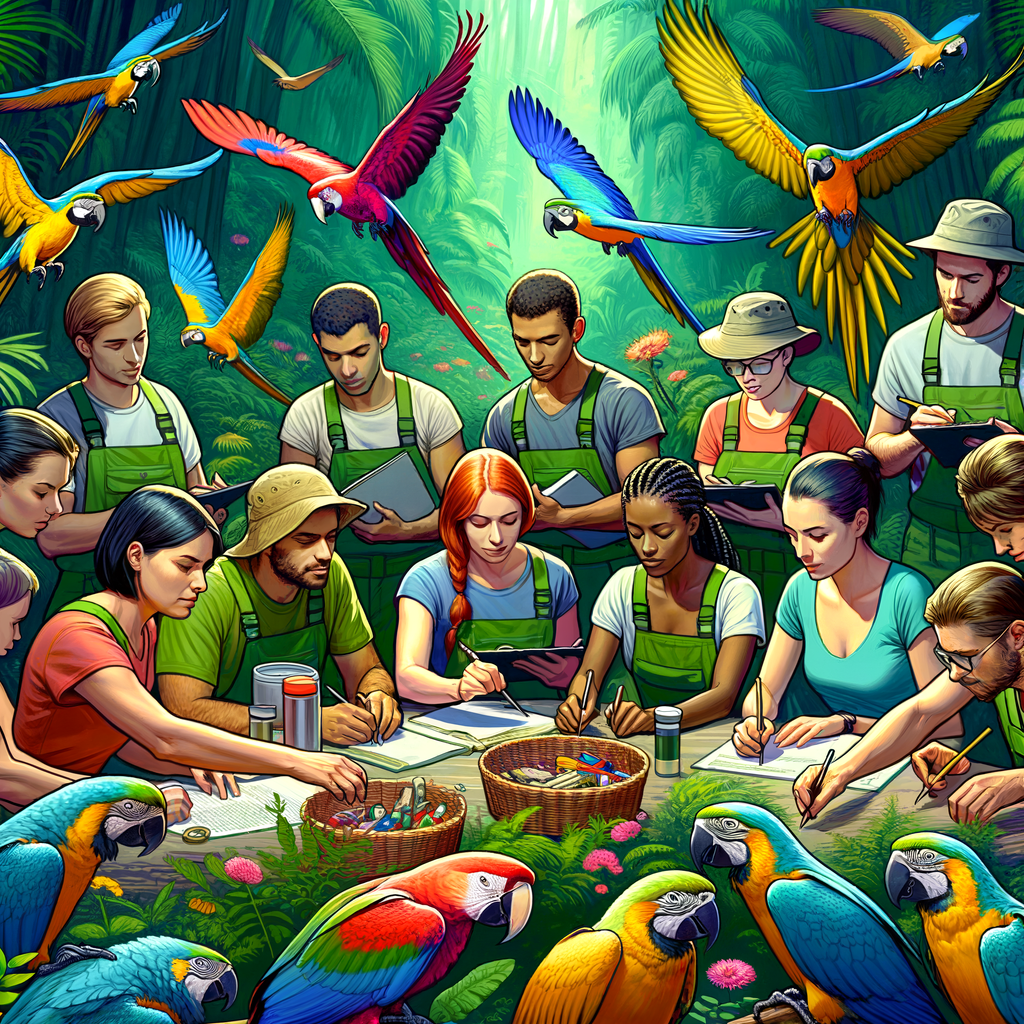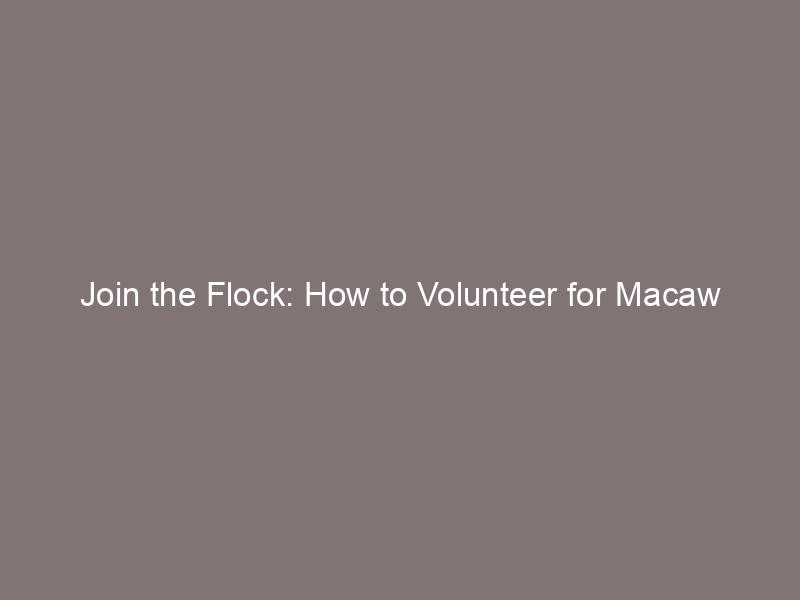
Introduction to Macaw Conservation Programs
Macaws, with their vibrant colors and playful personalities, are one of the most fascinating bird species in the world. However, these beautiful creatures are facing a serious threat due to habitat loss and illegal pet trade. This is where Macaw conservation programs come into play. These programs are dedicated to protecting and preserving these magnificent birds and their habitats for future generations.
- Understanding the Importance of Macaw Conservation
- Overview of Various Macaw Conservation Programs
- Role of Volunteers in Macaw Conservation
Macaws play a crucial role in maintaining the health of our ecosystems. They help in seed dispersal, which aids in forest regeneration. Unfortunately, due to human activities, their population is declining at an alarming rate. Conserving Macaws is not just about saving a single species; it’s about preserving the balance of our entire ecosystem.
There are numerous Macaw conservation programs worldwide, each with its unique approach to conservation. Some programs focus on habitat restoration, while others concentrate on breeding and reintroduction initiatives. For instance, the Ara Project in Costa Rica focuses on breeding and releasing Great Green Macaws and Scarlet Macaws into the wild. On the other hand, the Tambopata Macaw Project in Peru conducts research to understand the life history of Macaws and uses this knowledge to develop effective conservation strategies.
Volunteers play an essential role in Macaw conservation. They help in various tasks, including habitat restoration, monitoring bird populations, and educating local communities about the importance of conservation. Volunteering for Macaw conservation not only provides a unique opportunity to contribute to a meaningful cause but also allows individuals to learn about these magnificent creatures and their habitats.
In conclusion, Macaw conservation is a critical task that requires the collective effort of conservationists, local communities, and volunteers. By understanding the importance of Macaw conservation, learning about various conservation programs, and recognizing the role of volunteers, we can all contribute to the preservation of these beautiful birds and their habitats.
Volunteering with Macaws: What Does It Involve?
Volunteering with Macaws is a rewarding experience that involves various roles and responsibilities. Let’s delve into what you can expect when you decide to volunteer in this field.
Roles and Responsibilities
As a volunteer, you will play a crucial role in the conservation of these beautiful birds. Here are some of the tasks you might be involved in:
- Assisting with Macaw Rescue and Rehabilitation
- Participating in Macaw Protection Efforts
- Supporting Research and Data Collection
One of the primary responsibilities you might have is assisting in the rescue and rehabilitation of Macaws. This could involve caring for injured or sick birds, helping them recover, and preparing them for release back into the wild. It’s a hands-on role that requires patience and dedication.
Another important role you might play is participating in efforts to protect Macaws and their habitats. This could involve working on projects aimed at preserving their natural habitats, educating local communities about the importance of conservation, and advocating for policies that protect these birds.
Volunteers often play a vital role in supporting research and data collection efforts. This could involve observing Macaws in their natural habitats, collecting data on their behaviors and numbers, and assisting researchers in their studies. The data collected is crucial in informing conservation strategies and policies.
These roles and responsibilities are not exhaustive, and the specific tasks you might be involved in can vary depending on the needs of the organization you volunteer with. However, they give a good idea of what you can expect when volunteering with Macaws.
Skills and Qualifications
Volunteering with macaws is a rewarding experience, but it also requires certain skills and qualifications. Here are some of the key qualifications you should have if you’re considering this type of volunteer work:
- Interest in Wildlife Conservation
- Physical Fitness and Readiness for Fieldwork
- Ability to Work in a Team
Having a genuine interest in wildlife conservation is crucial. This passion will drive you to contribute positively to the cause. You’ll be helping to protect these beautiful birds and their habitats, so it’s important that you care about their survival.
Fieldwork can be physically demanding. You might need to navigate through dense forests or hike up hills to reach the macaws. Therefore, being physically fit and ready for such activities is essential. It’s not just about strength, but also endurance and agility.
Conservation work is a team effort. You’ll be working with other volunteers, conservationists, and sometimes local communities. Being able to work well in a team, communicate effectively, and collaborate with others is a key skill for this role.
In conclusion, volunteering with macaws is not just about the love for these birds. It also requires certain skills and qualifications. If you have an interest in wildlife conservation, are physically fit, and can work well in a team, you could make a significant contribution to the protection of these magnificent creatures.
How to Volunteer for Wildlife Conservation
Volunteering for wildlife conservation, specifically for bird species like Macaws, is a noble and fulfilling endeavor. It not only contributes to the protection of these beautiful creatures but also enriches your personal growth. Here are some steps you can follow to become a volunteer.
Steps to Become a Volunteer
- Researching bird conservation volunteer opportunities
- Applying for a volunteer position
- Preparing for your volunteering journey
Start by researching various wildlife conservation organizations that focus on bird species. Look for their volunteer programs and understand what they entail. Some organizations may require specific skills or experience, while others may welcome all willing volunteers. Consider factors such as location, duration, and the type of work involved.
Once you’ve found a program that suits your interests and abilities, the next step is to apply. This usually involves filling out an application form detailing your personal information, skills, and motivations for volunteering. Be honest and enthusiastic in your application. Remember, your passion for conservation is as important as any skills you may bring.
After your application is accepted, it’s time to prepare for your volunteering journey. This may involve travel arrangements, packing appropriate clothing and equipment, and mentally preparing yourself for the experience. It’s also a good idea to learn more about the species you’ll be helping and the challenges they face.
Volunteering for wildlife conservation is a significant commitment, but the rewards are immense. Not only will you be making a tangible difference in the lives of endangered species, but you’ll also gain valuable experience, skills, and memories that will last a lifetime.
Case Study: Successful Volunteer Experiences
Let’s dive into the real-life stories of individuals who have made a significant impact through their volunteer work in bird conservation. These case studies will give you a glimpse into what it’s like to volunteer in this field and the kind of difference you can make.
-
Case Study 1: A Volunteer’s Journey in a Macaw Rescue and Rehabilitation Center
Meet Sarah, a passionate bird lover who decided to spend her summer volunteering at a Macaw rescue and rehabilitation center in Costa Rica. Sarah’s primary responsibilities included feeding the birds, cleaning their habitats, and assisting with medical treatments.
One of her most memorable experiences was helping a young Macaw, named Rio, recover from a wing injury. Sarah worked closely with the center’s veterinarian to provide Rio with the necessary care. After weeks of rehabilitation, Rio was finally able to fly again. Sarah’s experience shows that volunteering can be both challenging and rewarding.
Key Takeaway Volunteering provides hands-on experience in wildlife care and rehabilitation. -
Case Study 2: Volunteering for Tropical Bird Conservation
Next, we have John, a university student who volunteered for a tropical bird conservation project in Brazil. John’s role involved conducting bird surveys, collecting data, and educating local communities about bird conservation.
One of John’s significant achievements was organizing a community event to raise awareness about the importance of preserving local bird species. The event was a success, with over 200 attendees and several local media coverage. John’s story demonstrates that volunteering can also involve community engagement and education.
Key Takeaway Volunteering can be a platform for raising awareness and educating others about wildlife conservation.
In conclusion, these case studies highlight the diverse experiences and opportunities that come with volunteering in bird conservation. Whether it’s hands-on care and rehabilitation or community education and engagement, your efforts can make a significant impact on preserving these beautiful creatures.
Endangered Bird Species Protection Volunteering
Volunteering for the protection of endangered bird species is a noble and fulfilling endeavor. It provides an opportunity to contribute to global bird conservation efforts, learn about various endangered bird species, and understand how each individual’s efforts can make a significant impact on the larger picture of wildlife conservation.
- Understanding the global bird conservation efforts
- Exploring other endangered bird species
- How volunteering contributes to the bigger picture of wildlife conservation
Global bird conservation is a collective effort by various organizations and individuals around the world. These efforts aim to protect and conserve bird species that are threatened by extinction due to factors such as habitat loss, climate change, and illegal hunting. Conservation strategies include habitat restoration, breeding programs, and legislative advocacy for bird protection laws.
Beyond macaws, there are numerous other bird species that are critically endangered. For instance, the California Condor, one of the world’s rarest bird species, has been brought back from the brink of extinction through concerted conservation efforts. Similarly, the Kakapo, a flightless parrot from New Zealand, is another species that has benefited from protective measures. By volunteering, you can learn about these and many other species that need our help.
Every volunteer plays a crucial role in the larger scheme of wildlife conservation. By dedicating your time and effort, you help in various ways. This can range from assisting in fieldwork, helping in rescue and rehabilitation centers, to raising awareness in your community. Each contribution, no matter how small, aids in the overall goal of preserving our planet’s biodiversity.
In conclusion, volunteering for the protection of endangered bird species is not just about the birds. It’s about preserving the natural world for future generations. It’s about understanding that every creature, no matter how small or insignificant it may seem, plays a vital role in our ecosystem. And most importantly, it’s about taking action and making a difference.
Conclusion: Join the Flock and Make a Difference
As we wrap up this informative journey, let’s take a moment to reflect on what we’ve learned and how we can make a difference in the world of Macaw conservation.
- Recap of the importance of Macaw conservation
- Final thoughts on volunteering for wildlife conservation
- Encouragement to join the volunteer for Macaw conservation movement
Macaws, with their vibrant colors and charismatic personalities, are an integral part of our planet’s biodiversity. However, they are under severe threat due to habitat loss and illegal pet trade. Their conservation is not just about saving a single species but about preserving the health and balance of our ecosystems. Every Macaw saved is a step towards a healthier, more diverse planet.
Volunteering for wildlife conservation is a noble and fulfilling endeavor. It’s about giving back to the planet that sustains us and ensuring that future generations can enjoy the same biodiversity we do today. Whether it’s through hands-on work in the field or raising awareness in your community, every effort counts.
Now that you’re armed with knowledge, it’s time to take action. Join the flock and make a difference in Macaw conservation. Your time, skills, and passion can help turn the tide for these magnificent birds. Remember, in the face of wildlife conservation, every individual counts, and that includes you.
Let’s not just stand by and watch as these beautiful creatures fade into oblivion. Let’s stand up, take action, and make a difference. Join the Macaw conservation movement today and help write a better future for our feathered friends.






